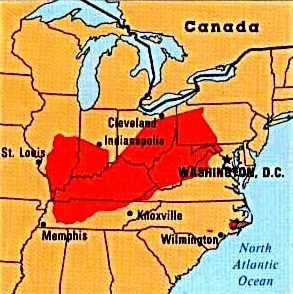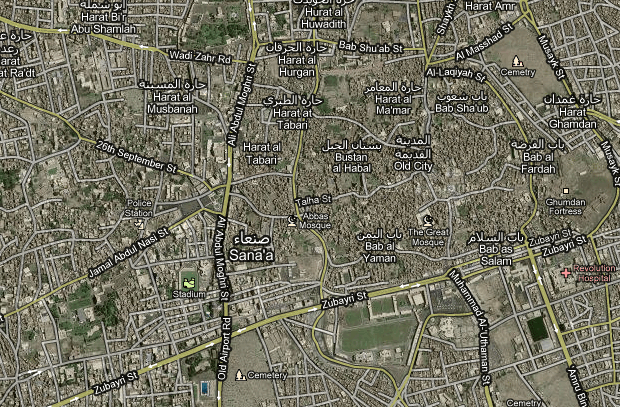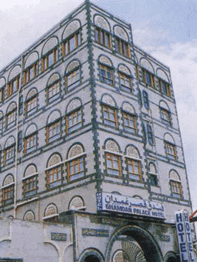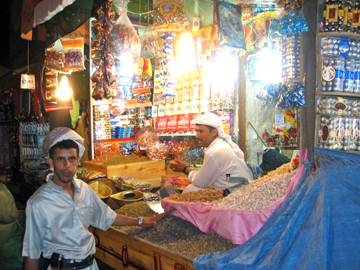Where is Yemen?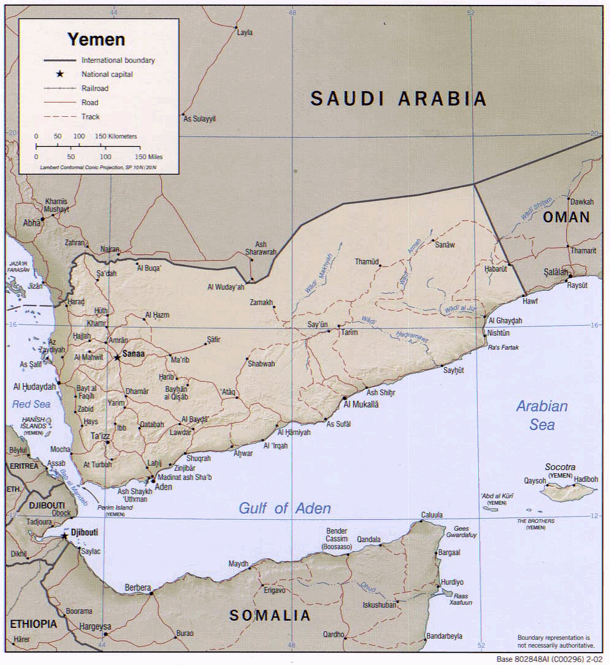
Roughly 300 miles north to south
700 miles east to westBordered by
Saudia Arabia
Oman
Red Sea
Gulf of Aden and Arabian Sea
Close to
Somalia
Ethiopia
Djibouti
Plus 200 islands
Population Approx 24 Million
Capital: Sana'a, pop. approx 2 million
Present Day Yemen is the only Republic in the region. Unified North Yemen and South Yemen in 1990.
Rich and diverse history through many dynasties, domination by other countries, and tribal traditions.
Mountains to the west up to over 12000 feet.
Historically diverse agriculture with extensive use of terraced fields and gravity irrigation.
Yemen was the start of many of the overland caravans taking goods arriving from the East at ports on the Arabian Sea and transporting them 1500 miles to the Mediterranean Sea on their route to Europe. Hundreds of years.
Great Marib Dam
Current economy dependent on oil production. Projected to be depleted by 2016. Intense effort to diversify (or re-diversify) the economy.
Comparison
Slightly larger in area than California; about 2/3 of California's population.
Background for my trip
Invited by Ministry of Education on behalf of University of Sana'a
Workshop on Mathematics Problem Solving
New Yemeni Curriculum on the preparation of mathematics teachers
Mandate for Mathematics faculty to teach a course on mathematics problem solving
Mastery Project for Mathematics and Science found my web site for UGa course
http://jwilson.coe.uga.edu/emt725/emt725.html
Correspondence led to an invitation to present a 5-day workshop for Yemeni Mathematics Faculty from 3 universities.
28 mathematics faculty, 26 with PhD in mathematics. 25 Men, 3 women.
22 were fluent in reading and speaking English, the other 6 moderately fluent in English
Workshop conducted in English with translation to Arabic. Plenary discussions were sometimes in Arabic (with translations for me) and sometimes in English.
Preparation
I prepared a web site for the Workshop based on my Problem Solving course web site.
The Mastery Project staff translated all of my materials to Arabic so that participants would have both the English version on line and the Arabic version in hard copy.
In addition to extended correspondence, we had three days of planning in Sana'a prior to the workshop.
Sana'a
Elevation 7300 ft. Getting acclimated was hard.
Ancient city. Site of Sheba.
Muslim. Many Mosques. Call to prayer at 4:00 a.m.
University of Sana'a
Hotel Ghamdan Palace
Homes and Businesses in Sana'a
Almost all homes are multigenerational. Traditionally 5 stories with the first floor for animals or for a business.
Lots of Toyotas, especially older models; many newer cars are small Fords.
Old City-
Walled. Very narrow, winding streets.
Shops along streets. Some on second floor of building
Vendors in the plazas
Travel to Mountain villages
Permission to travel out of Sana'a was obtained from the Minister of the Interior. Documents were required at each military check-point. We passed through 5 of them during the 120 mile round trip.
Roads built by the Chinese Government.
Many villages built on mountain tops for defense and for water conservation. Many sites trace back over 2000 years.
Even barren looking land carefully terraced for growing crops and for irrigation. Most working of the land by hand. Occasionally a donkey was seen in the fields. Only one tractor spotted on our 120 mile drive.
My Workshop
Very positive experience. Better than I thought possible. Every participant sought me out at the end to thank me.
Other Observations and Comments
Qat
Widely used. Fresh green leaves are chewed. The juice is a mild stimulant.
Both women and men.
The Food!!!
Many different kinds of bread.
Lots of vegetable and grain dishes I would describe as like a casserole.
Fish and meat.
Strong links to African Cuisine.
Customs --
Sitting on the floor or at most on a cushion
Eating without a fork. Use pieces of bread to pick up and consume the food.
The People
Abaya -- traditional black cover-up worn by women. Many women do not cover the face with a veil. Those who do, do it from tradition rather than being required.
Sharshaf -- also a cover-up, usually black, often with other colors.
Western Women NOT expected to wear an abaya or use a veil. Yemeni's appreciate that Western Women would wear a head covering but it would not be 'required.'
Very open and friendly. Never an indication of hostility. No aversion from my camera.
Visit to a home for traditional family dinner.
Security
Today's Situation
